U.S.-bound shipments fall for first time in 24 months in February, says Panjiva

United States-bound waterborne shipments dropped for the first time in 24 months, according to data issued this week by global trade intelligence firm Panjiva.
February shipments, at 909,947, fell 4.5% annually, with containerized freight handled shipments down 4%. What’s more, this decline follows an aggregate increase of 5.5% over the previous three months.
Panjiva pointed to imports out of China as a main driver for February’s decline, falling 9.9% annually, coming on the heels of an aggregate 6.6% gain over the previous three months. And it added that the shipment slowdown is due, in large part, to the end of stockpiling that had been intact in the past in advance of “expected-and now twice delayed-increases in tariffs on Chinese imports.”
What’s more, the firm said that is likely to remain the case, as a trade deal between the U.S. and China, possibly by the end of this month, could continue to curtail import levels while inventories get worked through.
In an interview, Panjiva Research Director Chris Rogers explained that along with the delay on tariff increases and the potential U.S.-China trade deal, the timing of the Lunar New Year also served as a lever for February’s decline in shipments.
“These are the first signs of a broader economic downturn in global trade,” said Rogers. “One thing that is worrying to me is that it is not just a decline in shipments from China, it is also a decline out of Europe, South Korea, and Japan. There is a slowdown in shipments from several Asian countries. It is not a huge surprise, really. Every wave has its crest. And it is something U.S. businesses will have to deal with, as it is not the only nation with political issues. There is Brexit in the U.K. as well which is going to hurt trade. On a macroeconomic level, things are quite challenging.”
The challenges are clearly outlined in Panjiva’s data, too, when looking at the eight product categories it tracks all seeing declines in February.
Furniture shipments, which became subject to duties on Chinese exports for the first time in September, dropped 10.2% in February, following a 10.8% cumulative increase over the previous three months. And apparel import slipped 3.4%, following 19 consecutive months of expansion, which Panjiva said was “surprising” and indicative of a slippage in consumer spending activity.
Panjiva also pointed to a decline in shipments related to industrial supply chains, with February imports of chemicals and steel down 11.1% and 10.1%, respectively, and automotive component and vehicle shipments down the for fourth straight month, which it said most likely indicates expectations of ongoing sales weakness. It added that while capital goods imports were more robust, shipments fell 2.4%, and coupled with a decline in ISM manufacturing sentiment, Panjiva said further weakness is possible.
When asked about how the third quarter is shaping up, to date, in terms of shipment activity, Rogers said that the combination of weakening economic data from enough nations and ocean freight rates at its lowest level since July 2018 and driven by excess supply and lower demand, point to things remaining at current levels.
“It is tough to see March being better, he said. “There is continuing uncertainty in regards to the U.S.-China trade deal, with no signs of a conclusion until April. Businesses will not make any big decisions until they see details of the trade deal, which could also lead to continued weakness in shipment levels.”

Article Topics
Global Trade News & Resources
Supply Chain Stability Index sees ‘Tremendous Improvement’ in 2023 Descartes March Global Shipping Report highlights ongoing steady volume momentum U.S.-bound import growth track remains promising, notes Port Tracker report EU Update 2024: Crises lead to growth Examining the impact of the Taiwan earthquake on global supply chain operations Descartes announces acquisition of OCR Services Inc. Industry experts examine the impact of Baltimore bridge collapse on supply chains More Global TradeLatest in Logistics
LM Podcast Series: Assessing the freight transportation and logistics markets with Tom Nightingale, AFS Logistics Investor expectations continue to influence supply chain decision-making The Next Big Steps in Supply Chain Digitalization Warehouse/DC Automation & Technology: Time to gain a competitive advantage The Ultimate WMS Checklist: Find the Perfect Fit Under-21 driver pilot program a bust with fleets as FMCSA seeks changes Diesel back over $4 a gallon; Mideast tensions, other worries cited More LogisticsAbout the Author
Subscribe to Logistics Management Magazine

Find out what the world's most innovative companies are doing to improve productivity in their plants and distribution centers.
Start your FREE subscription today.
April 2023 Logistics Management

Latest Resources














